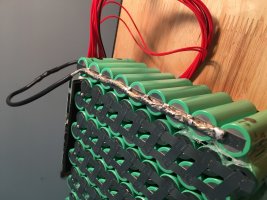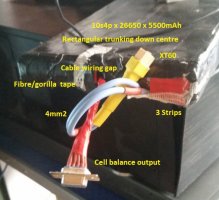garolittle
Member
- Joined
- Oct 27, 2017
- Messages
- 100
I recently finished a project duringwhich I upgraded the motor and charge controller on a Razor Ground Force Drifter. Specifically, I added a 48v 1,000W motor and charge controller to the go kart and powered it with a 14S9P 18650 battery pack.
As you can see from the picture below,I soldered 12 AWG to the positive and negative terminals which led to the charge controller. My next project will involve a larger go kart using a 72V motor/charge controller and a 72V 18650 battery pack. I would like to use larger wires (8 AWG or 6 AWG) but I believe the wires willbe too large to connect toterminals using solder. Does anyone have an idea of how to safely attach the larger gauge wire to the battery terminals? Thanks for any advice you can offer.

As you can see from the picture below,I soldered 12 AWG to the positive and negative terminals which led to the charge controller. My next project will involve a larger go kart using a 72V motor/charge controller and a 72V 18650 battery pack. I would like to use larger wires (8 AWG or 6 AWG) but I believe the wires willbe too large to connect toterminals using solder. Does anyone have an idea of how to safely attach the larger gauge wire to the battery terminals? Thanks for any advice you can offer.




